Corporate Accounting Analysis: Investment and Consolidation
VerifiedAdded on 2020/04/07
|19
|2925
|73
Homework Assignment
AI Summary
This document provides a comprehensive solution to a corporate accounting assignment. It begins by analyzing various investment relationships, determining the presence of control and the need for consolidation in each scenario. The analysis includes assessing power, rights, and variable returns, along with the application of relevant accounting standards. The solution then delves into an acquisition analysis, including the calculation of goodwill and the preparation of journal entries and a balance sheet. Furthermore, the assignment addresses deferred tax accounting, providing a worksheet and journal entries to illustrate the process. Finally, the assignment examines goodwill measurement in the context of equity interest exchanges and deemed acquisitions, and it concludes with a detailed consolidation analysis, including journal entries, a consolidated income statement, and a consolidated balance sheet. The assignment demonstrates a strong understanding of corporate accounting principles and their practical application.
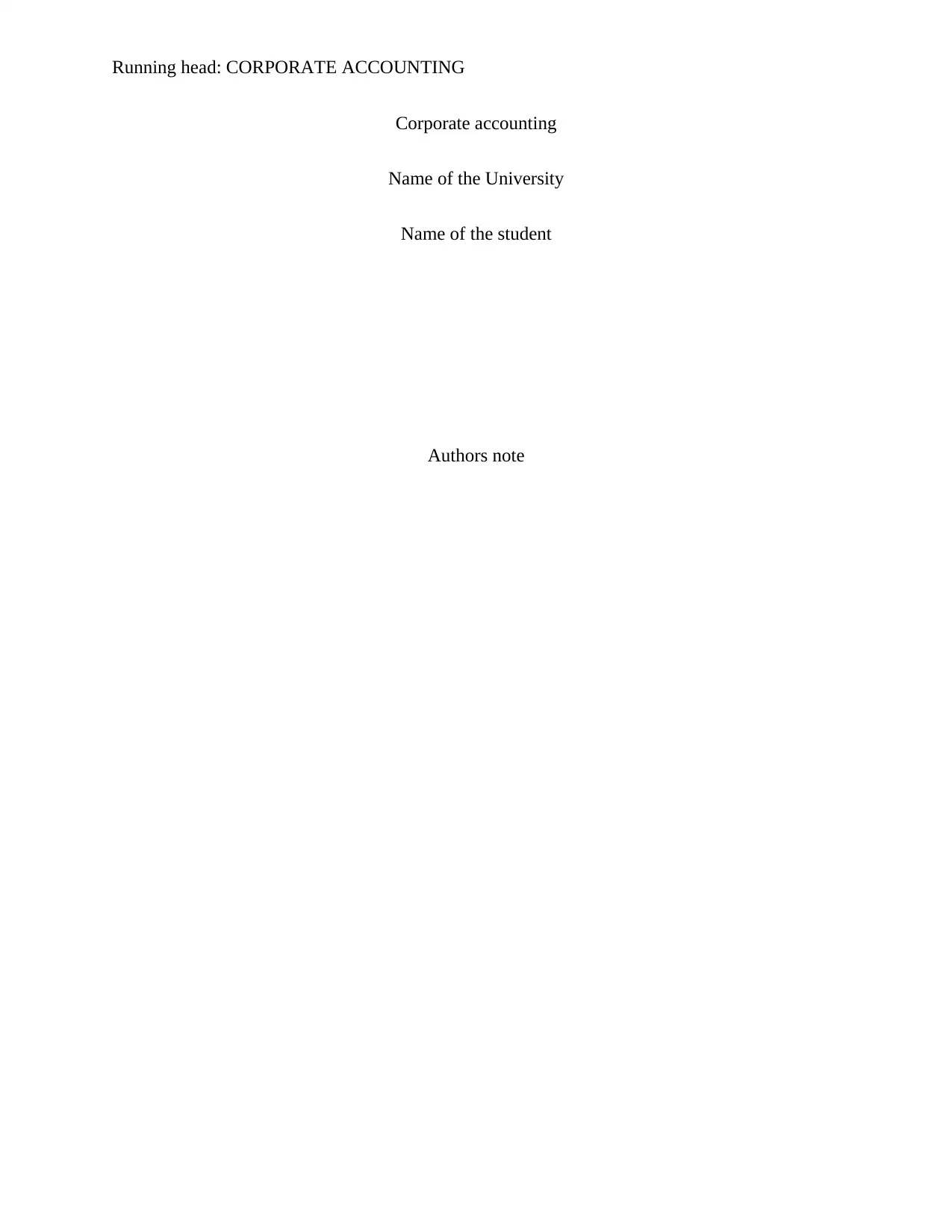
Running head: CORPORATE ACCOUNTING
Corporate accounting
Name of the University
Name of the student
Authors note
Corporate accounting
Name of the University
Name of the student
Authors note
Paraphrase This Document
Need a fresh take? Get an instant paraphrase of this document with our AI Paraphraser
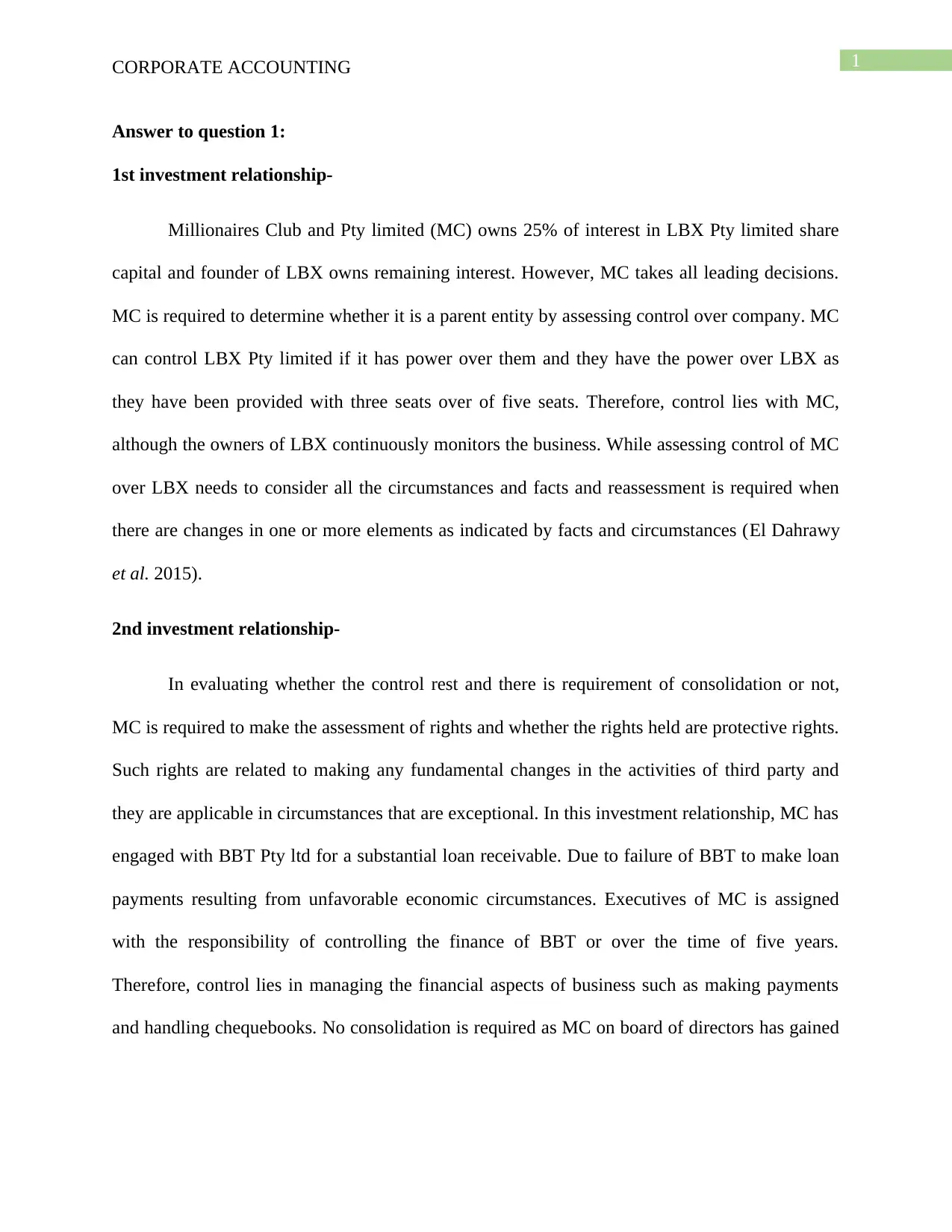
1CORPORATE ACCOUNTING
Answer to question 1:
1st investment relationship-
Millionaires Club and Pty limited (MC) owns 25% of interest in LBX Pty limited share
capital and founder of LBX owns remaining interest. However, MC takes all leading decisions.
MC is required to determine whether it is a parent entity by assessing control over company. MC
can control LBX Pty limited if it has power over them and they have the power over LBX as
they have been provided with three seats over of five seats. Therefore, control lies with MC,
although the owners of LBX continuously monitors the business. While assessing control of MC
over LBX needs to consider all the circumstances and facts and reassessment is required when
there are changes in one or more elements as indicated by facts and circumstances (El Dahrawy
et al. 2015).
2nd investment relationship-
In evaluating whether the control rest and there is requirement of consolidation or not,
MC is required to make the assessment of rights and whether the rights held are protective rights.
Such rights are related to making any fundamental changes in the activities of third party and
they are applicable in circumstances that are exceptional. In this investment relationship, MC has
engaged with BBT Pty ltd for a substantial loan receivable. Due to failure of BBT to make loan
payments resulting from unfavorable economic circumstances. Executives of MC is assigned
with the responsibility of controlling the finance of BBT or over the time of five years.
Therefore, control lies in managing the financial aspects of business such as making payments
and handling chequebooks. No consolidation is required as MC on board of directors has gained
Answer to question 1:
1st investment relationship-
Millionaires Club and Pty limited (MC) owns 25% of interest in LBX Pty limited share
capital and founder of LBX owns remaining interest. However, MC takes all leading decisions.
MC is required to determine whether it is a parent entity by assessing control over company. MC
can control LBX Pty limited if it has power over them and they have the power over LBX as
they have been provided with three seats over of five seats. Therefore, control lies with MC,
although the owners of LBX continuously monitors the business. While assessing control of MC
over LBX needs to consider all the circumstances and facts and reassessment is required when
there are changes in one or more elements as indicated by facts and circumstances (El Dahrawy
et al. 2015).
2nd investment relationship-
In evaluating whether the control rest and there is requirement of consolidation or not,
MC is required to make the assessment of rights and whether the rights held are protective rights.
Such rights are related to making any fundamental changes in the activities of third party and
they are applicable in circumstances that are exceptional. In this investment relationship, MC has
engaged with BBT Pty ltd for a substantial loan receivable. Due to failure of BBT to make loan
payments resulting from unfavorable economic circumstances. Executives of MC is assigned
with the responsibility of controlling the finance of BBT or over the time of five years.
Therefore, control lies in managing the financial aspects of business such as making payments
and handling chequebooks. No consolidation is required as MC on board of directors has gained
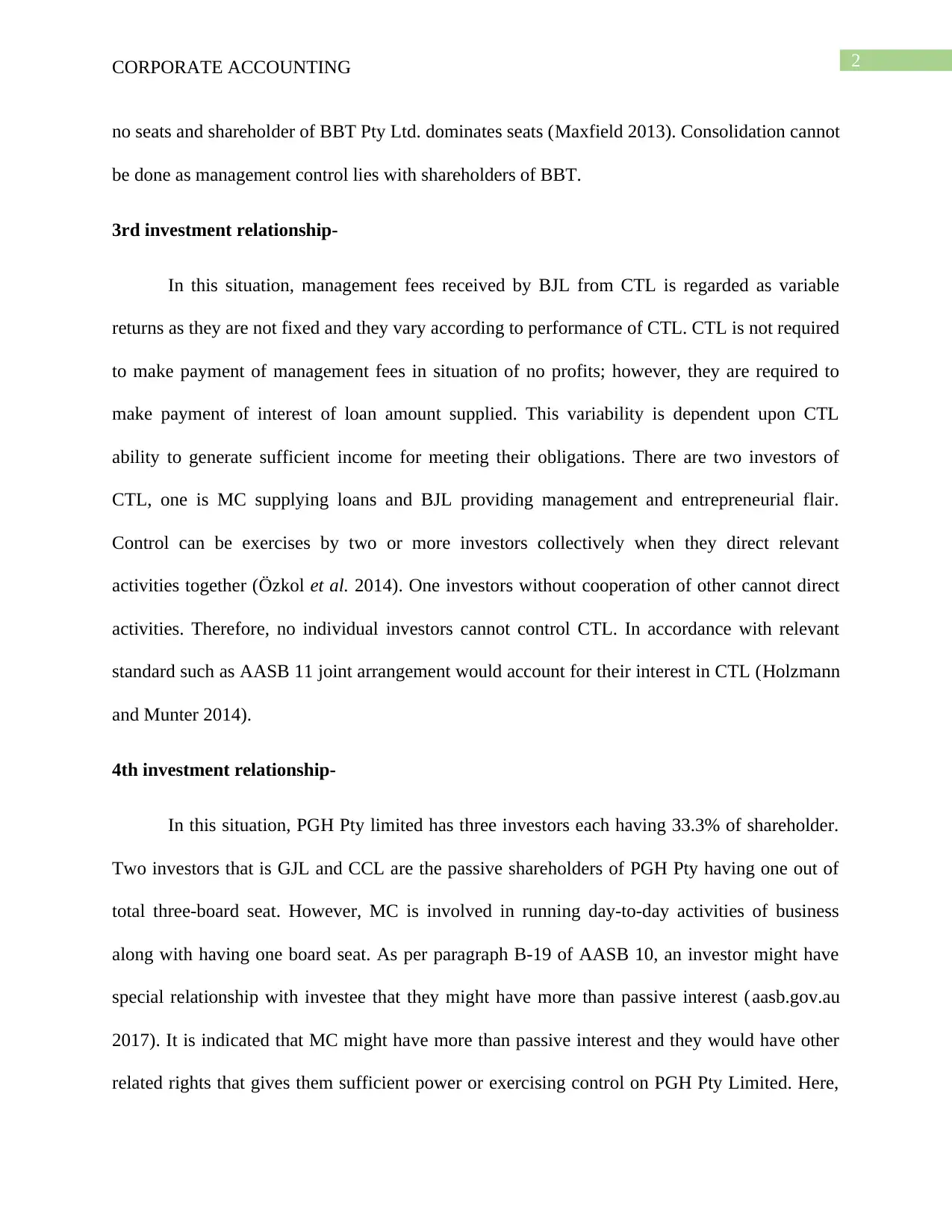
2CORPORATE ACCOUNTING
no seats and shareholder of BBT Pty Ltd. dominates seats (Maxfield 2013). Consolidation cannot
be done as management control lies with shareholders of BBT.
3rd investment relationship-
In this situation, management fees received by BJL from CTL is regarded as variable
returns as they are not fixed and they vary according to performance of CTL. CTL is not required
to make payment of management fees in situation of no profits; however, they are required to
make payment of interest of loan amount supplied. This variability is dependent upon CTL
ability to generate sufficient income for meeting their obligations. There are two investors of
CTL, one is MC supplying loans and BJL providing management and entrepreneurial flair.
Control can be exercises by two or more investors collectively when they direct relevant
activities together (Özkol et al. 2014). One investors without cooperation of other cannot direct
activities. Therefore, no individual investors cannot control CTL. In accordance with relevant
standard such as AASB 11 joint arrangement would account for their interest in CTL (Holzmann
and Munter 2014).
4th investment relationship-
In this situation, PGH Pty limited has three investors each having 33.3% of shareholder.
Two investors that is GJL and CCL are the passive shareholders of PGH Pty having one out of
total three-board seat. However, MC is involved in running day-to-day activities of business
along with having one board seat. As per paragraph B-19 of AASB 10, an investor might have
special relationship with investee that they might have more than passive interest (aasb.gov.au
2017). It is indicated that MC might have more than passive interest and they would have other
related rights that gives them sufficient power or exercising control on PGH Pty Limited. Here,
no seats and shareholder of BBT Pty Ltd. dominates seats (Maxfield 2013). Consolidation cannot
be done as management control lies with shareholders of BBT.
3rd investment relationship-
In this situation, management fees received by BJL from CTL is regarded as variable
returns as they are not fixed and they vary according to performance of CTL. CTL is not required
to make payment of management fees in situation of no profits; however, they are required to
make payment of interest of loan amount supplied. This variability is dependent upon CTL
ability to generate sufficient income for meeting their obligations. There are two investors of
CTL, one is MC supplying loans and BJL providing management and entrepreneurial flair.
Control can be exercises by two or more investors collectively when they direct relevant
activities together (Özkol et al. 2014). One investors without cooperation of other cannot direct
activities. Therefore, no individual investors cannot control CTL. In accordance with relevant
standard such as AASB 11 joint arrangement would account for their interest in CTL (Holzmann
and Munter 2014).
4th investment relationship-
In this situation, PGH Pty limited has three investors each having 33.3% of shareholder.
Two investors that is GJL and CCL are the passive shareholders of PGH Pty having one out of
total three-board seat. However, MC is involved in running day-to-day activities of business
along with having one board seat. As per paragraph B-19 of AASB 10, an investor might have
special relationship with investee that they might have more than passive interest (aasb.gov.au
2017). It is indicated that MC might have more than passive interest and they would have other
related rights that gives them sufficient power or exercising control on PGH Pty Limited. Here,
⊘ This is a preview!⊘
Do you want full access?
Subscribe today to unlock all pages.

Trusted by 1+ million students worldwide
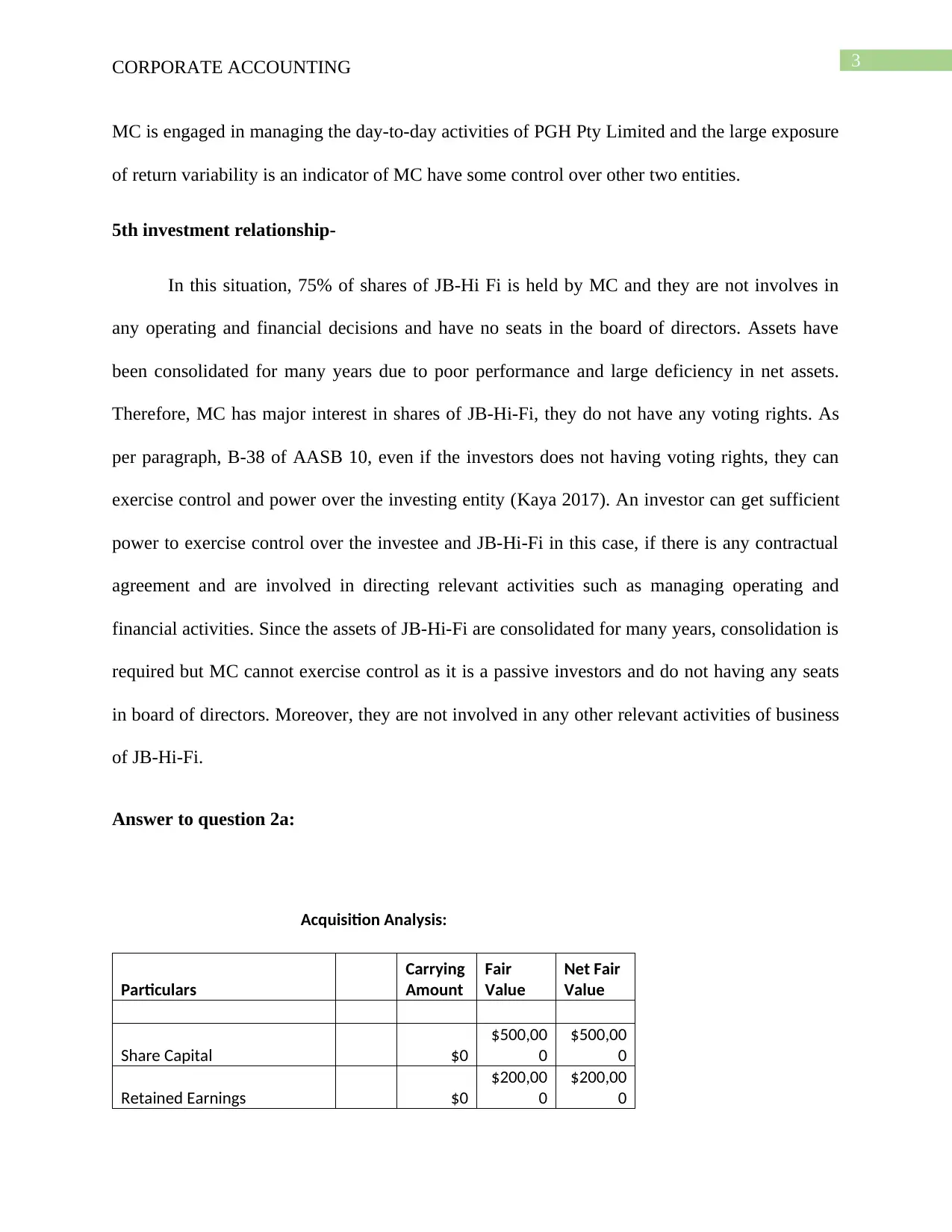
3CORPORATE ACCOUNTING
MC is engaged in managing the day-to-day activities of PGH Pty Limited and the large exposure
of return variability is an indicator of MC have some control over other two entities.
5th investment relationship-
In this situation, 75% of shares of JB-Hi Fi is held by MC and they are not involves in
any operating and financial decisions and have no seats in the board of directors. Assets have
been consolidated for many years due to poor performance and large deficiency in net assets.
Therefore, MC has major interest in shares of JB-Hi-Fi, they do not have any voting rights. As
per paragraph, B-38 of AASB 10, even if the investors does not having voting rights, they can
exercise control and power over the investing entity (Kaya 2017). An investor can get sufficient
power to exercise control over the investee and JB-Hi-Fi in this case, if there is any contractual
agreement and are involved in directing relevant activities such as managing operating and
financial activities. Since the assets of JB-Hi-Fi are consolidated for many years, consolidation is
required but MC cannot exercise control as it is a passive investors and do not having any seats
in board of directors. Moreover, they are not involved in any other relevant activities of business
of JB-Hi-Fi.
Answer to question 2a:
Acquisition Analysis:
Particulars
Carrying
Amount
Fair
Value
Net Fair
Value
Share Capital $0
$500,00
0
$500,00
0
Retained Earnings $0
$200,00
0
$200,00
0
MC is engaged in managing the day-to-day activities of PGH Pty Limited and the large exposure
of return variability is an indicator of MC have some control over other two entities.
5th investment relationship-
In this situation, 75% of shares of JB-Hi Fi is held by MC and they are not involves in
any operating and financial decisions and have no seats in the board of directors. Assets have
been consolidated for many years due to poor performance and large deficiency in net assets.
Therefore, MC has major interest in shares of JB-Hi-Fi, they do not have any voting rights. As
per paragraph, B-38 of AASB 10, even if the investors does not having voting rights, they can
exercise control and power over the investing entity (Kaya 2017). An investor can get sufficient
power to exercise control over the investee and JB-Hi-Fi in this case, if there is any contractual
agreement and are involved in directing relevant activities such as managing operating and
financial activities. Since the assets of JB-Hi-Fi are consolidated for many years, consolidation is
required but MC cannot exercise control as it is a passive investors and do not having any seats
in board of directors. Moreover, they are not involved in any other relevant activities of business
of JB-Hi-Fi.
Answer to question 2a:
Acquisition Analysis:
Particulars
Carrying
Amount
Fair
Value
Net Fair
Value
Share Capital $0
$500,00
0
$500,00
0
Retained Earnings $0
$200,00
0
$200,00
0
Paraphrase This Document
Need a fresh take? Get an instant paraphrase of this document with our AI Paraphraser
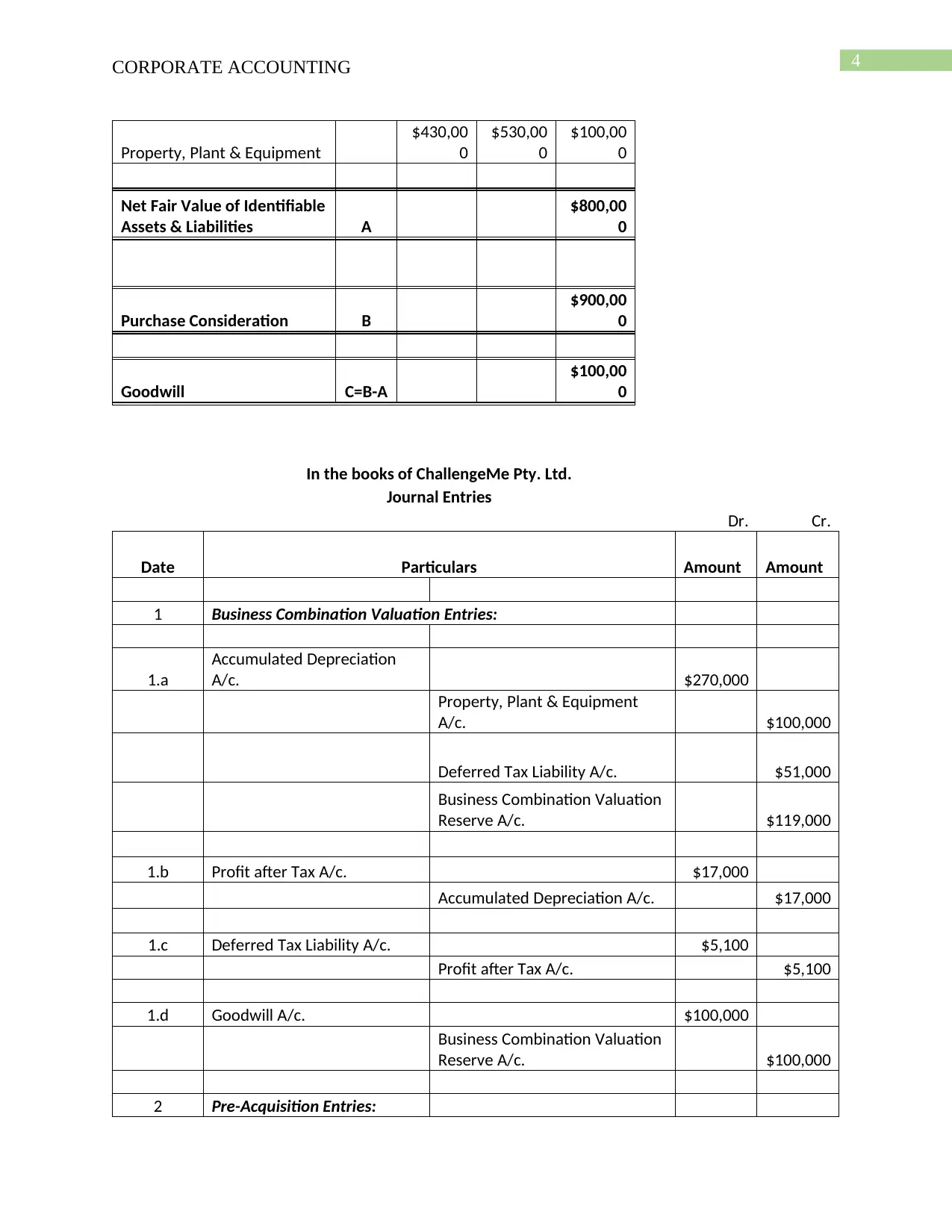
4CORPORATE ACCOUNTING
Property, Plant & Equipment
$430,00
0
$530,00
0
$100,00
0
Net Fair Value of Identifiable
Assets & Liabilities A
$800,00
0
Purchase Consideration B
$900,00
0
Goodwill C=B-A
$100,00
0
In the books of ChallengeMe Pty. Ltd.
Journal Entries
Dr. Cr.
Date Particulars Amount Amount
1 Business Combination Valuation Entries:
1.a
Accumulated Depreciation
A/c. $270,000
Property, Plant & Equipment
A/c. $100,000
Deferred Tax Liability A/c. $51,000
Business Combination Valuation
Reserve A/c. $119,000
1.b Profit after Tax A/c. $17,000
Accumulated Depreciation A/c. $17,000
1.c Deferred Tax Liability A/c. $5,100
Profit after Tax A/c. $5,100
1.d Goodwill A/c. $100,000
Business Combination Valuation
Reserve A/c. $100,000
2 Pre-Acquisition Entries:
Property, Plant & Equipment
$430,00
0
$530,00
0
$100,00
0
Net Fair Value of Identifiable
Assets & Liabilities A
$800,00
0
Purchase Consideration B
$900,00
0
Goodwill C=B-A
$100,00
0
In the books of ChallengeMe Pty. Ltd.
Journal Entries
Dr. Cr.
Date Particulars Amount Amount
1 Business Combination Valuation Entries:
1.a
Accumulated Depreciation
A/c. $270,000
Property, Plant & Equipment
A/c. $100,000
Deferred Tax Liability A/c. $51,000
Business Combination Valuation
Reserve A/c. $119,000
1.b Profit after Tax A/c. $17,000
Accumulated Depreciation A/c. $17,000
1.c Deferred Tax Liability A/c. $5,100
Profit after Tax A/c. $5,100
1.d Goodwill A/c. $100,000
Business Combination Valuation
Reserve A/c. $100,000
2 Pre-Acquisition Entries:
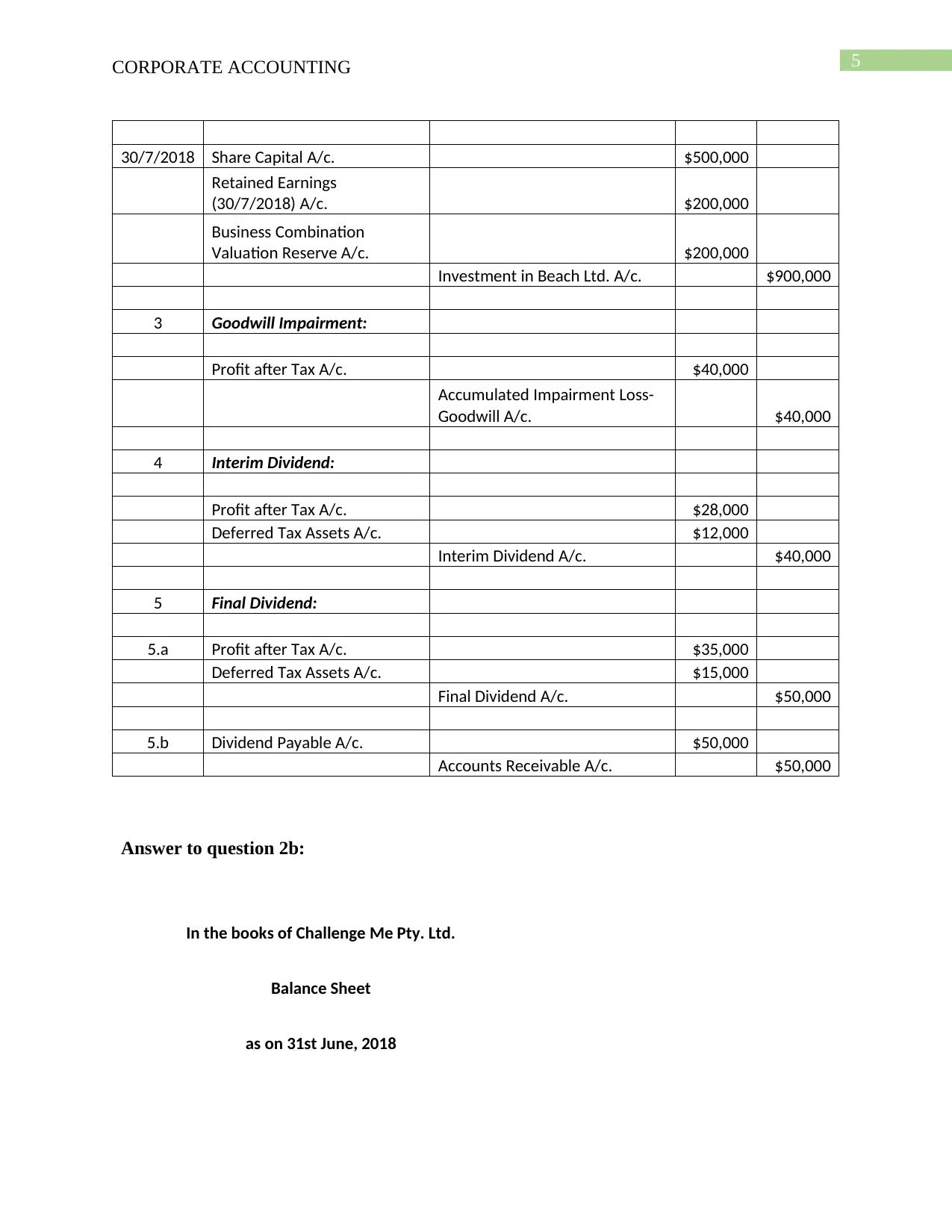
5CORPORATE ACCOUNTING
30/7/2018 Share Capital A/c. $500,000
Retained Earnings
(30/7/2018) A/c. $200,000
Business Combination
Valuation Reserve A/c. $200,000
Investment in Beach Ltd. A/c. $900,000
3 Goodwill Impairment:
Profit after Tax A/c. $40,000
Accumulated Impairment Loss-
Goodwill A/c. $40,000
4 Interim Dividend:
Profit after Tax A/c. $28,000
Deferred Tax Assets A/c. $12,000
Interim Dividend A/c. $40,000
5 Final Dividend:
5.a Profit after Tax A/c. $35,000
Deferred Tax Assets A/c. $15,000
Final Dividend A/c. $50,000
5.b Dividend Payable A/c. $50,000
Accounts Receivable A/c. $50,000
Answer to question 2b:
In the books of Challenge Me Pty. Ltd.
Balance Sheet
as on 31st June, 2018
30/7/2018 Share Capital A/c. $500,000
Retained Earnings
(30/7/2018) A/c. $200,000
Business Combination
Valuation Reserve A/c. $200,000
Investment in Beach Ltd. A/c. $900,000
3 Goodwill Impairment:
Profit after Tax A/c. $40,000
Accumulated Impairment Loss-
Goodwill A/c. $40,000
4 Interim Dividend:
Profit after Tax A/c. $28,000
Deferred Tax Assets A/c. $12,000
Interim Dividend A/c. $40,000
5 Final Dividend:
5.a Profit after Tax A/c. $35,000
Deferred Tax Assets A/c. $15,000
Final Dividend A/c. $50,000
5.b Dividend Payable A/c. $50,000
Accounts Receivable A/c. $50,000
Answer to question 2b:
In the books of Challenge Me Pty. Ltd.
Balance Sheet
as on 31st June, 2018
⊘ This is a preview!⊘
Do you want full access?
Subscribe today to unlock all pages.

Trusted by 1+ million students worldwide
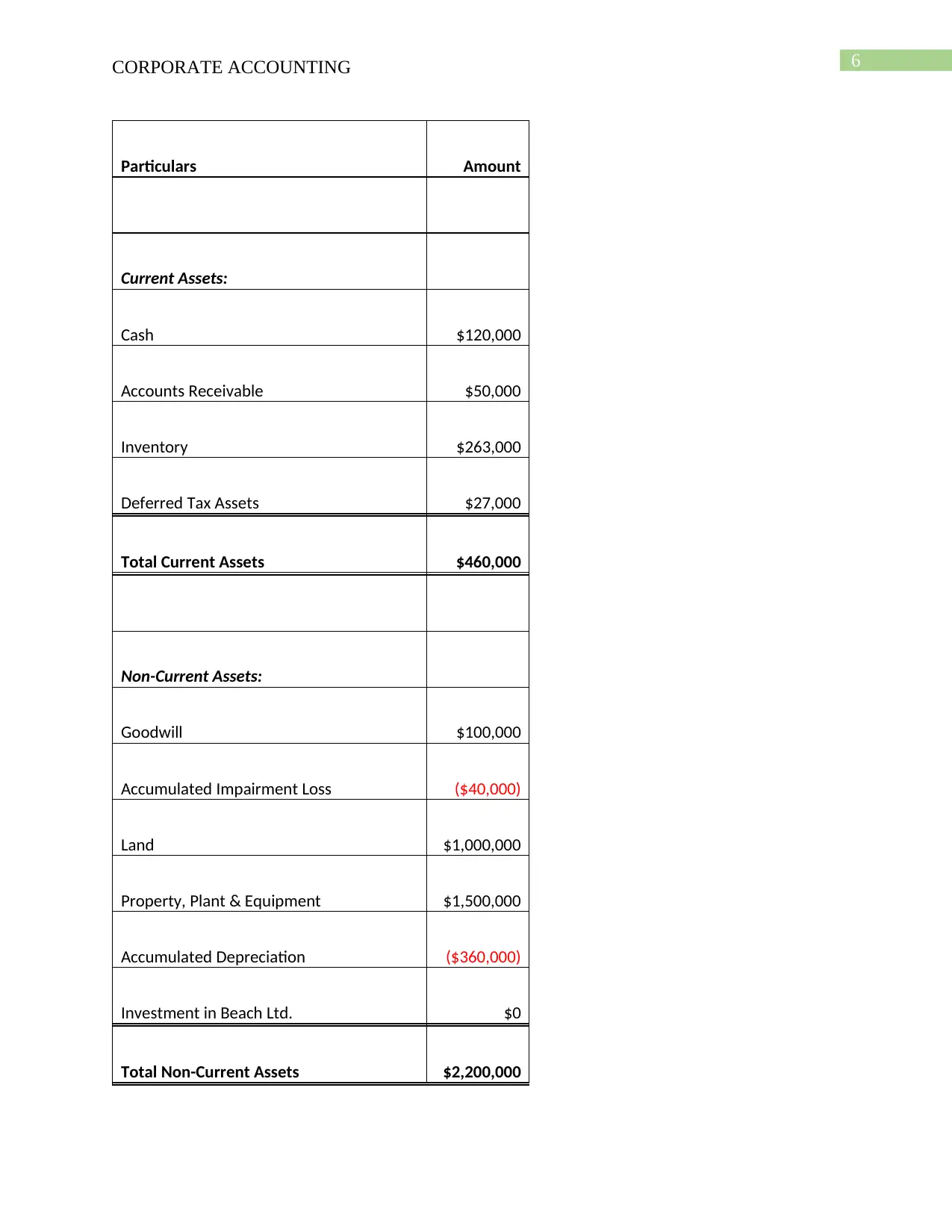
6CORPORATE ACCOUNTING
Particulars Amount
Current Assets:
Cash $120,000
Accounts Receivable $50,000
Inventory $263,000
Deferred Tax Assets $27,000
Total Current Assets $460,000
Non-Current Assets:
Goodwill $100,000
Accumulated Impairment Loss ($40,000)
Land $1,000,000
Property, Plant & Equipment $1,500,000
Accumulated Depreciation ($360,000)
Investment in Beach Ltd. $0
Total Non-Current Assets $2,200,000
Particulars Amount
Current Assets:
Cash $120,000
Accounts Receivable $50,000
Inventory $263,000
Deferred Tax Assets $27,000
Total Current Assets $460,000
Non-Current Assets:
Goodwill $100,000
Accumulated Impairment Loss ($40,000)
Land $1,000,000
Property, Plant & Equipment $1,500,000
Accumulated Depreciation ($360,000)
Investment in Beach Ltd. $0
Total Non-Current Assets $2,200,000
Paraphrase This Document
Need a fresh take? Get an instant paraphrase of this document with our AI Paraphraser
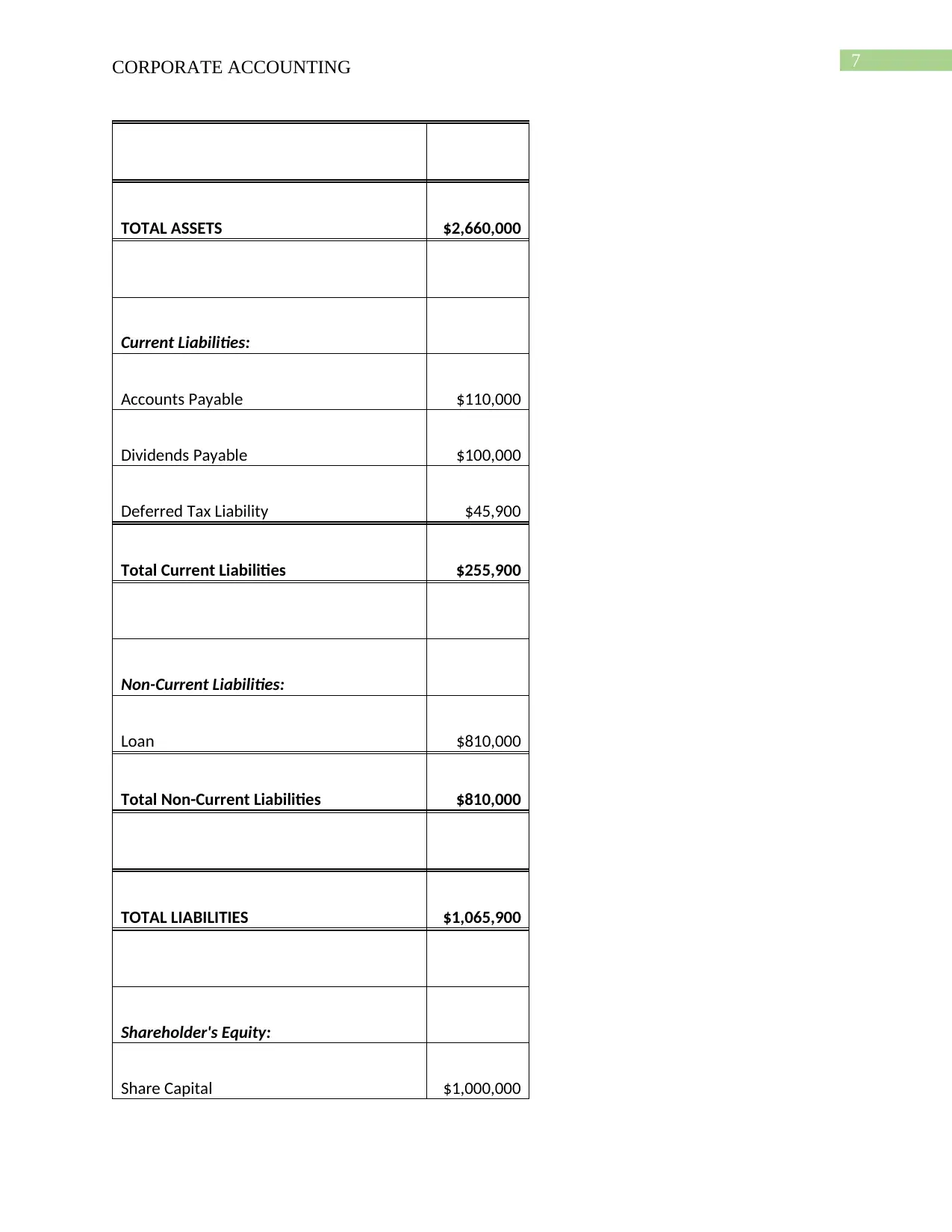
7CORPORATE ACCOUNTING
TOTAL ASSETS $2,660,000
Current Liabilities:
Accounts Payable $110,000
Dividends Payable $100,000
Deferred Tax Liability $45,900
Total Current Liabilities $255,900
Non-Current Liabilities:
Loan $810,000
Total Non-Current Liabilities $810,000
TOTAL LIABILITIES $1,065,900
Shareholder's Equity:
Share Capital $1,000,000
TOTAL ASSETS $2,660,000
Current Liabilities:
Accounts Payable $110,000
Dividends Payable $100,000
Deferred Tax Liability $45,900
Total Current Liabilities $255,900
Non-Current Liabilities:
Loan $810,000
Total Non-Current Liabilities $810,000
TOTAL LIABILITIES $1,065,900
Shareholder's Equity:
Share Capital $1,000,000
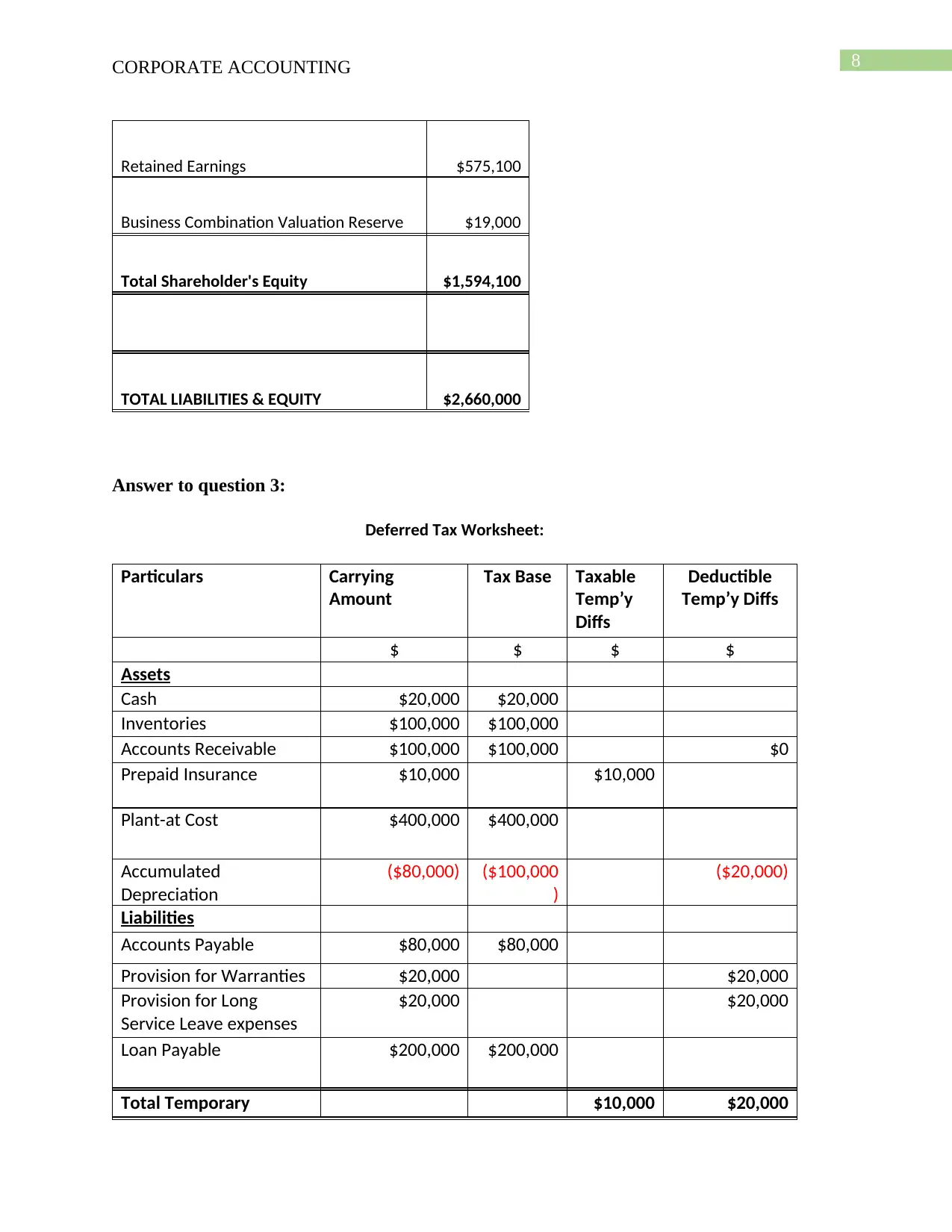
8CORPORATE ACCOUNTING
Retained Earnings $575,100
Business Combination Valuation Reserve $19,000
Total Shareholder's Equity $1,594,100
TOTAL LIABILITIES & EQUITY $2,660,000
Answer to question 3:
Deferred Tax Worksheet:
Particulars Carrying
Amount
Tax Base Taxable
Temp’y
Diffs
Deductible
Temp’y Diffs
$ $ $ $
Assets
Cash $20,000 $20,000
Inventories $100,000 $100,000
Accounts Receivable $100,000 $100,000 $0
Prepaid Insurance $10,000 $10,000
Plant-at Cost $400,000 $400,000
Accumulated
Depreciation
($80,000) ($100,000
)
($20,000)
Liabilities
Accounts Payable $80,000 $80,000
Provision for Warranties $20,000 $20,000
Provision for Long
Service Leave expenses
$20,000 $20,000
Loan Payable $200,000 $200,000
Total Temporary $10,000 $20,000
Retained Earnings $575,100
Business Combination Valuation Reserve $19,000
Total Shareholder's Equity $1,594,100
TOTAL LIABILITIES & EQUITY $2,660,000
Answer to question 3:
Deferred Tax Worksheet:
Particulars Carrying
Amount
Tax Base Taxable
Temp’y
Diffs
Deductible
Temp’y Diffs
$ $ $ $
Assets
Cash $20,000 $20,000
Inventories $100,000 $100,000
Accounts Receivable $100,000 $100,000 $0
Prepaid Insurance $10,000 $10,000
Plant-at Cost $400,000 $400,000
Accumulated
Depreciation
($80,000) ($100,000
)
($20,000)
Liabilities
Accounts Payable $80,000 $80,000
Provision for Warranties $20,000 $20,000
Provision for Long
Service Leave expenses
$20,000 $20,000
Loan Payable $200,000 $200,000
Total Temporary $10,000 $20,000
⊘ This is a preview!⊘
Do you want full access?
Subscribe today to unlock all pages.

Trusted by 1+ million students worldwide
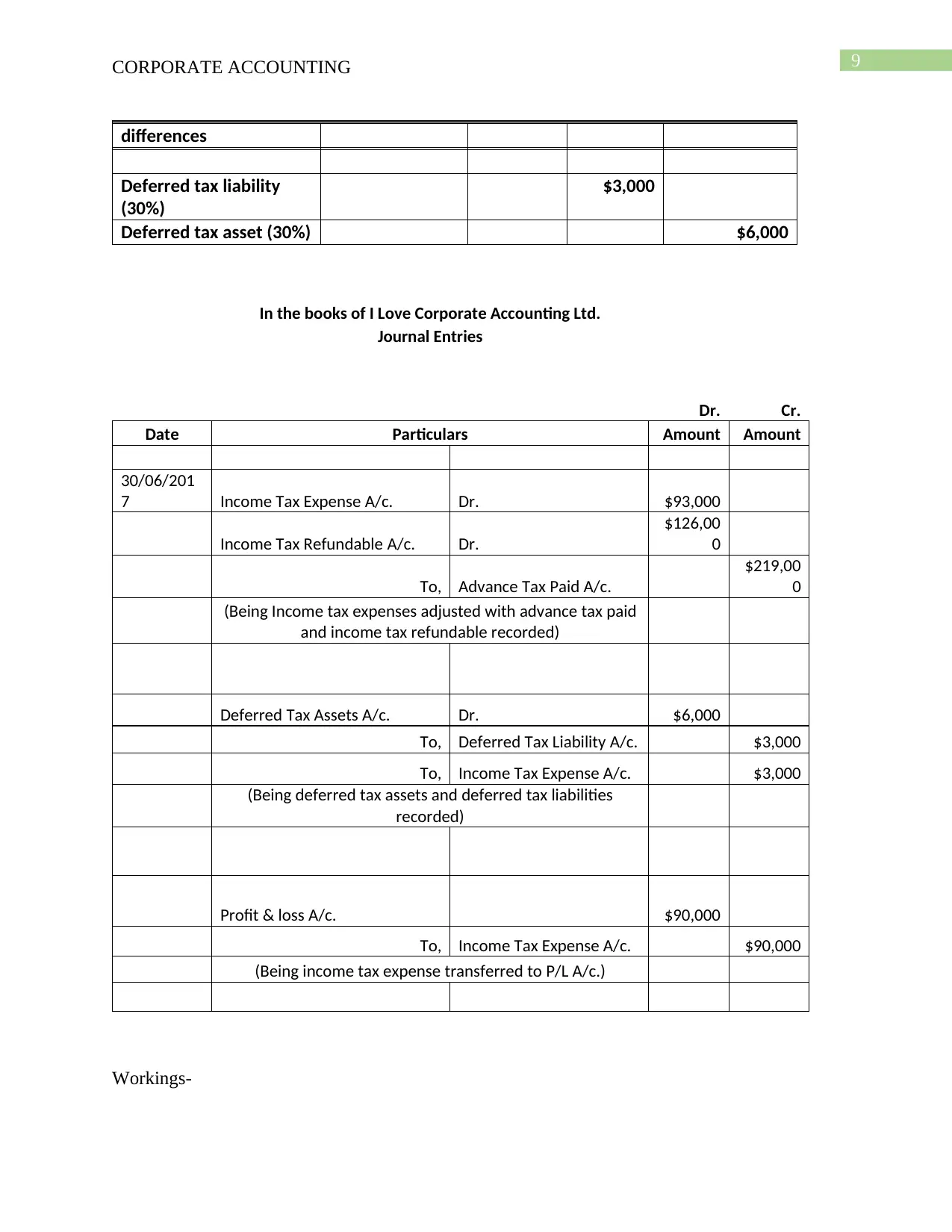
9CORPORATE ACCOUNTING
differences
Deferred tax liability
(30%)
$3,000
Deferred tax asset (30%) $6,000
In the books of I Love Corporate Accounting Ltd.
Journal Entries
Dr. Cr.
Date Particulars Amount Amount
30/06/201
7 Income Tax Expense A/c. Dr. $93,000
Income Tax Refundable A/c. Dr.
$126,00
0
To, Advance Tax Paid A/c.
$219,00
0
(Being Income tax expenses adjusted with advance tax paid
and income tax refundable recorded)
Deferred Tax Assets A/c. Dr. $6,000
To, Deferred Tax Liability A/c. $3,000
To, Income Tax Expense A/c. $3,000
(Being deferred tax assets and deferred tax liabilities
recorded)
Profit & loss A/c. $90,000
To, Income Tax Expense A/c. $90,000
(Being income tax expense transferred to P/L A/c.)
Workings-
differences
Deferred tax liability
(30%)
$3,000
Deferred tax asset (30%) $6,000
In the books of I Love Corporate Accounting Ltd.
Journal Entries
Dr. Cr.
Date Particulars Amount Amount
30/06/201
7 Income Tax Expense A/c. Dr. $93,000
Income Tax Refundable A/c. Dr.
$126,00
0
To, Advance Tax Paid A/c.
$219,00
0
(Being Income tax expenses adjusted with advance tax paid
and income tax refundable recorded)
Deferred Tax Assets A/c. Dr. $6,000
To, Deferred Tax Liability A/c. $3,000
To, Income Tax Expense A/c. $3,000
(Being deferred tax assets and deferred tax liabilities
recorded)
Profit & loss A/c. $90,000
To, Income Tax Expense A/c. $90,000
(Being income tax expense transferred to P/L A/c.)
Workings-
Paraphrase This Document
Need a fresh take? Get an instant paraphrase of this document with our AI Paraphraser
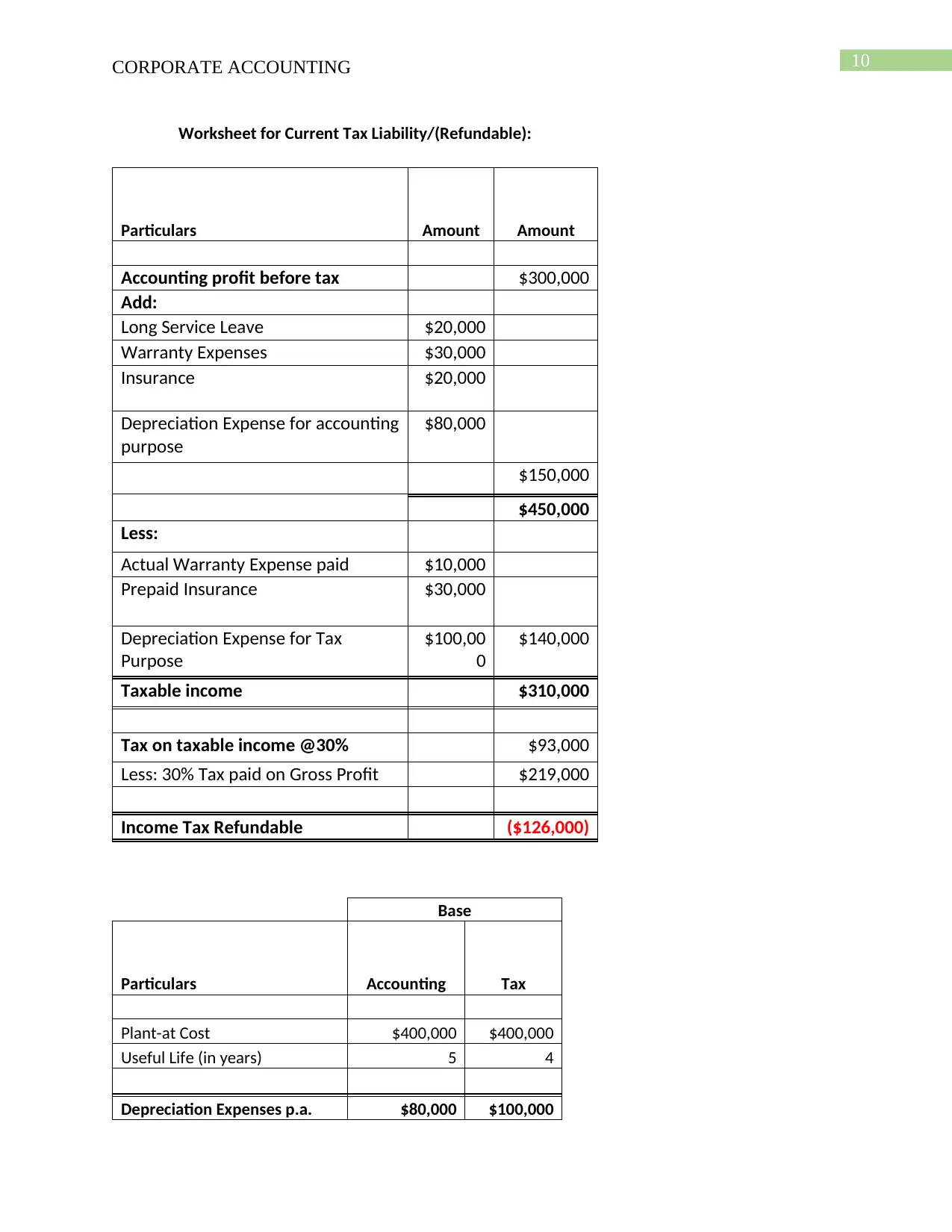
10CORPORATE ACCOUNTING
Worksheet for Current Tax Liability/(Refundable):
Particulars Amount Amount
Accounting profit before tax $300,000
Add:
Long Service Leave $20,000
Warranty Expenses $30,000
Insurance $20,000
Depreciation Expense for accounting
purpose
$80,000
$150,000
$450,000
Less:
Actual Warranty Expense paid $10,000
Prepaid Insurance $30,000
Depreciation Expense for Tax
Purpose
$100,00
0
$140,000
Taxable income $310,000
Tax on taxable income @30% $93,000
Less: 30% Tax paid on Gross Profit $219,000
Income Tax Refundable ($126,000)
Base
Particulars Accounting Tax
Plant-at Cost $400,000 $400,000
Useful Life (in years) 5 4
Depreciation Expenses p.a. $80,000 $100,000
Worksheet for Current Tax Liability/(Refundable):
Particulars Amount Amount
Accounting profit before tax $300,000
Add:
Long Service Leave $20,000
Warranty Expenses $30,000
Insurance $20,000
Depreciation Expense for accounting
purpose
$80,000
$150,000
$450,000
Less:
Actual Warranty Expense paid $10,000
Prepaid Insurance $30,000
Depreciation Expense for Tax
Purpose
$100,00
0
$140,000
Taxable income $310,000
Tax on taxable income @30% $93,000
Less: 30% Tax paid on Gross Profit $219,000
Income Tax Refundable ($126,000)
Base
Particulars Accounting Tax
Plant-at Cost $400,000 $400,000
Useful Life (in years) 5 4
Depreciation Expenses p.a. $80,000 $100,000
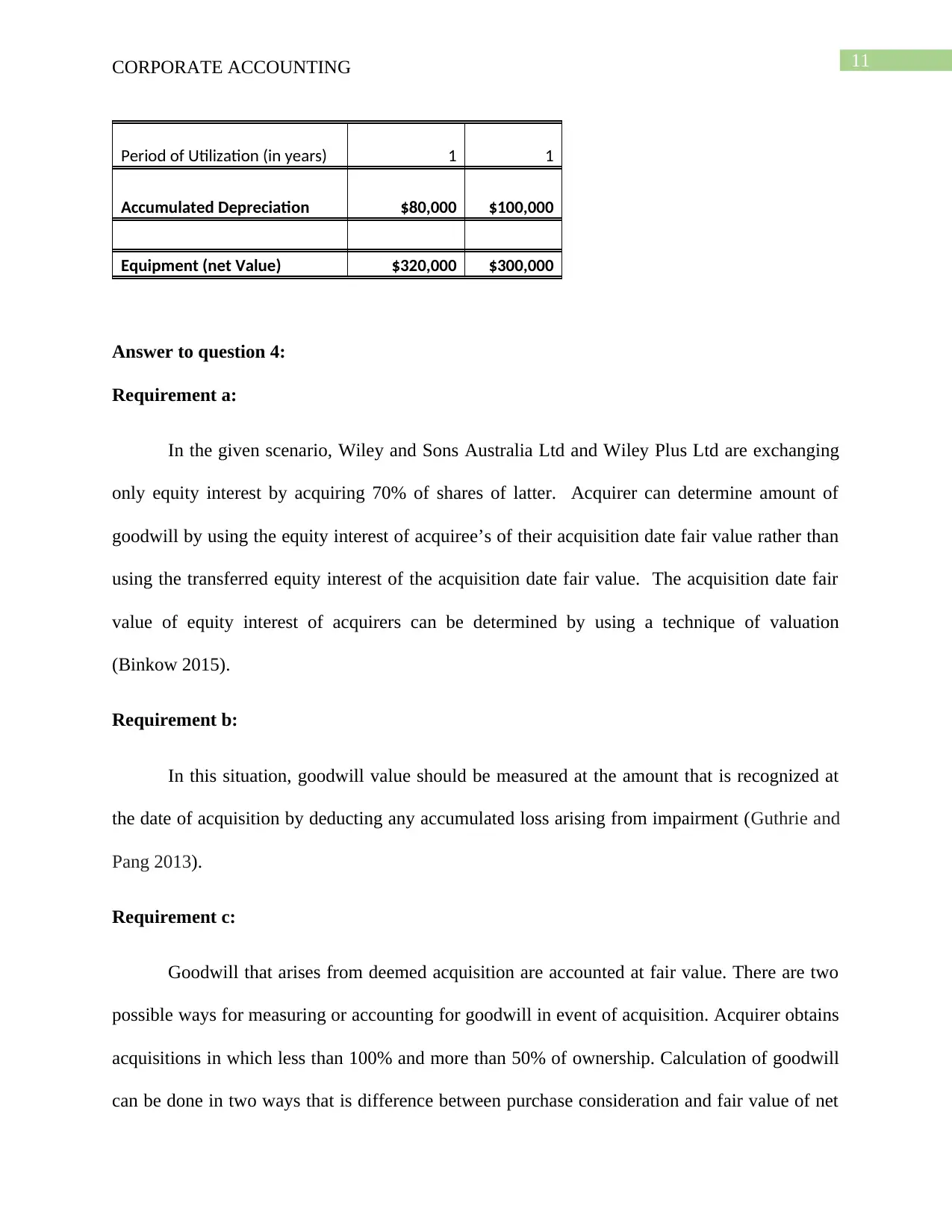
11CORPORATE ACCOUNTING
Period of Utilization (in years) 1 1
Accumulated Depreciation $80,000 $100,000
Equipment (net Value) $320,000 $300,000
Answer to question 4:
Requirement a:
In the given scenario, Wiley and Sons Australia Ltd and Wiley Plus Ltd are exchanging
only equity interest by acquiring 70% of shares of latter. Acquirer can determine amount of
goodwill by using the equity interest of acquiree’s of their acquisition date fair value rather than
using the transferred equity interest of the acquisition date fair value. The acquisition date fair
value of equity interest of acquirers can be determined by using a technique of valuation
(Binkow 2015).
Requirement b:
In this situation, goodwill value should be measured at the amount that is recognized at
the date of acquisition by deducting any accumulated loss arising from impairment (Guthrie and
Pang 2013).
Requirement c:
Goodwill that arises from deemed acquisition are accounted at fair value. There are two
possible ways for measuring or accounting for goodwill in event of acquisition. Acquirer obtains
acquisitions in which less than 100% and more than 50% of ownership. Calculation of goodwill
can be done in two ways that is difference between purchase consideration and fair value of net
Period of Utilization (in years) 1 1
Accumulated Depreciation $80,000 $100,000
Equipment (net Value) $320,000 $300,000
Answer to question 4:
Requirement a:
In the given scenario, Wiley and Sons Australia Ltd and Wiley Plus Ltd are exchanging
only equity interest by acquiring 70% of shares of latter. Acquirer can determine amount of
goodwill by using the equity interest of acquiree’s of their acquisition date fair value rather than
using the transferred equity interest of the acquisition date fair value. The acquisition date fair
value of equity interest of acquirers can be determined by using a technique of valuation
(Binkow 2015).
Requirement b:
In this situation, goodwill value should be measured at the amount that is recognized at
the date of acquisition by deducting any accumulated loss arising from impairment (Guthrie and
Pang 2013).
Requirement c:
Goodwill that arises from deemed acquisition are accounted at fair value. There are two
possible ways for measuring or accounting for goodwill in event of acquisition. Acquirer obtains
acquisitions in which less than 100% and more than 50% of ownership. Calculation of goodwill
can be done in two ways that is difference between purchase consideration and fair value of net
⊘ This is a preview!⊘
Do you want full access?
Subscribe today to unlock all pages.

Trusted by 1+ million students worldwide
1 out of 19
Related Documents
Your All-in-One AI-Powered Toolkit for Academic Success.
+13062052269
info@desklib.com
Available 24*7 on WhatsApp / Email
![[object Object]](/_next/static/media/star-bottom.7253800d.svg)
Unlock your academic potential
Copyright © 2020–2025 A2Z Services. All Rights Reserved. Developed and managed by ZUCOL.





